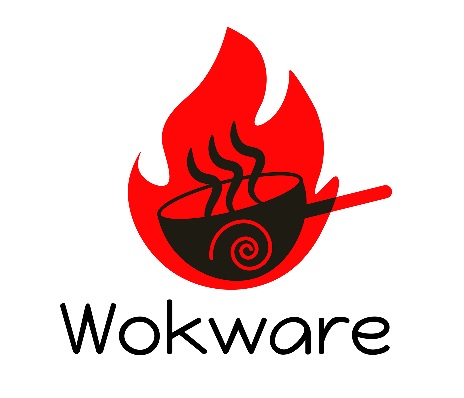Updated on April 2023
Stainless steel vs all other woks
Wokware is reader supported. When you buy through links on our site, we may earn an affiliate commission. Learn Here.
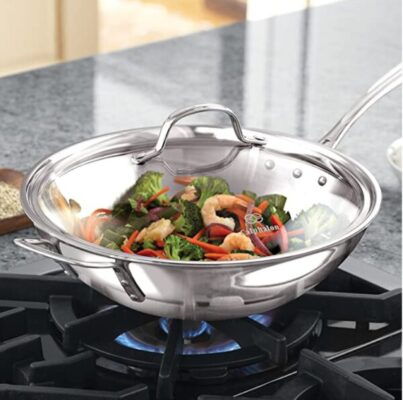
Summary:
A carbon steel wok is the best stir frying tool then any metal because of its even heat distribution. Stainless steel wok is classy and the easiest to maintain. Cast iron is good for searing but not better than carbon steel wok at stir frying. And anodized aluminum woks are safer than nonstick coated woks but not great at stir frying like a carbon steel wok.
Several decades ago, iron woks were used as a multipurpose kitchen tool. And often to maintain an iron pan cooks spend hours in the kitchen. Also, iron is rust-prone. Clearly, it is not an ideal wok material for our busy schedule.
Thankfully, we can get several alloy-built woks nowadays. For the buyer’s ease of use, market has introduced-
- Stainless steel woks,
- carbon steel woks,
- cast iron woks,
- aluminum woks,
- with non-stick coating,
- without non-stick coating – you name it, and the market has it.
Iron woks are also there. However, I have already established iron woks are not at all feasible to maintain, so we will be looking only at the differences, pros, and pitfalls of other materials used in manufacturing a wok.

For the easiness of comparison, we have kept stainless steel as a constant and compared it with carbon steel, cast iron, aluminum, and non-stick woks.
I will make sure to address the most common queries a chef or a home cook has while choosing a material type for the wok.
Stainless steel wok or carbon steel wok
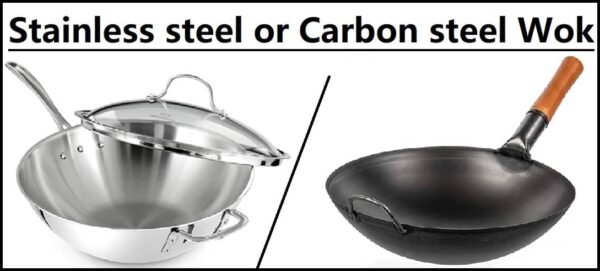
I have compared Stainless Steel Wok Vs Carbon steel wok based on their features, price range, flavor retention ability, using, cleaning, and storing ease.
Carbon steel woks are now one of the most popular woks around the world. As carbon steel is very good at heat conduction and distribution, for stir fry (which is a high heat cooking technique), it is the best material.
Carbon steel woks are deep, have thin yet sturdy walls, and lightweight hence suitable for flipping and tossing the food while cooking stir fry. They come in different styles and quality, but the best of them is the round-bottomed ones, made of two sheets of carbon steel and hand-forged.
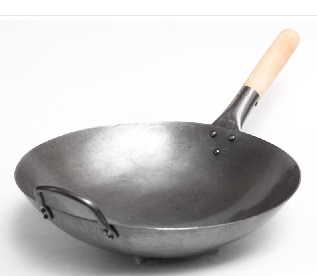
The hand-forged or hand-hammered carbon steel woks are the most traditional of all. They are highly durable. They often go through 12 processes and up to 36000 times of hand hammering just to bring that even finish on the surface of the wok.
This type of woks are incredibly sturdy and made for extremely high heat cooking. Those who want a wok for outdoor cooking like on a high BTU burner, for them a hand hammered round bottom carbon steel wok is the best choice.
Mammafong is currently the top brand offering hand hammered carbon steel made woks. This particular round bottom wok is very well balanced and has a smooth bubble-free surface to give you that ‘wok-hei’ flavor in your food. With proper seasoning, this wok will become your prized possession.
However, keeping on mind the needs of a home cook who just want a wok for regular use, several manufacturers have introduced a modernized version of carbon steel wok. Like this preseasoned flat bottom wok from Yosukata can be used on gas, open fire, induction, ceramic, and electric stovetop.
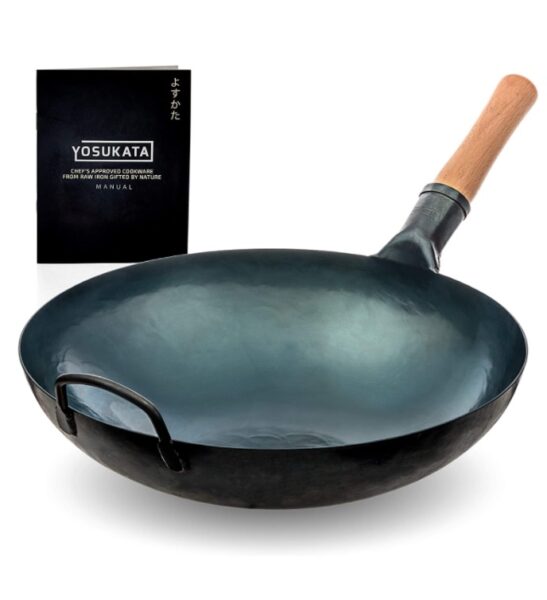
To know more about hand hammered carbon steel woks, read this very useful guide.
Which is better: Stainless steel or Carbon steel wok?
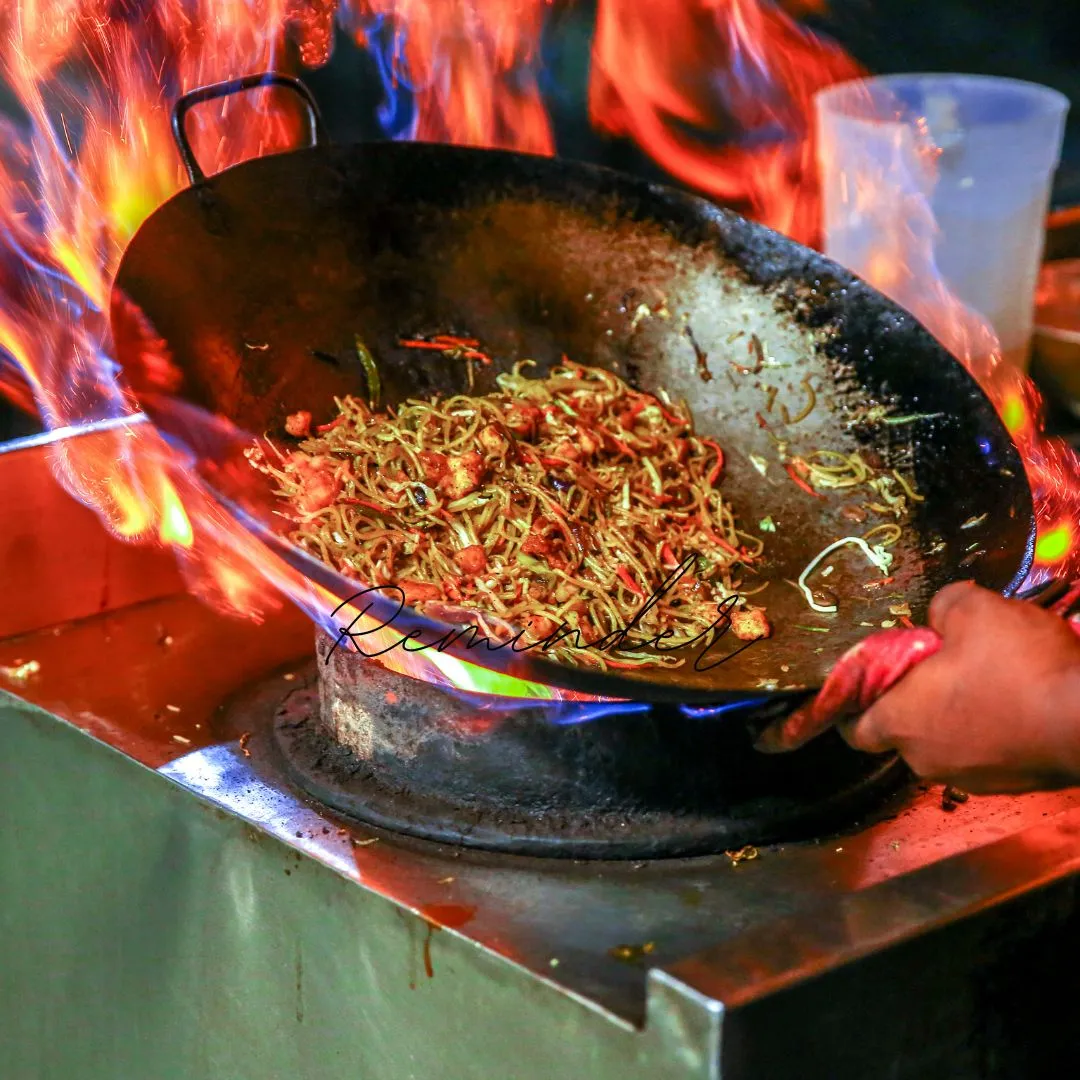
When the question ‘stainless steel wok or carbon steel wok’ comes to your mind, you should consider various factors such as maintenance, depth of flavor, heat distribution, etc.
A stainless steel wok gives hotspots and has an inferior heat distribution than a carbon steel wok. And hence food cooked in stainless steel woks will give a lower depth of flavor. At the same time, they are easy to maintain. They don’t need to be seasoned occasionally like carbon steel wok, are sturdy, and wouldn’t deform easily, whereas carbon steel woks need periodic seasoning. And the entire seasoning process needs precision, effort, and time.
However, the heat retention capacity of carbon steel woks is relatively lower, which means that your food will remain warm in a stainless steel wok than in a carbon steel wok.
Also, crucial to note, that the market has now brought stainless steel woks with aluminum core. As aluminum is better at heat distribution than carbon steel, these stainless steel woks with the sandwiched bottom are appealing choices.
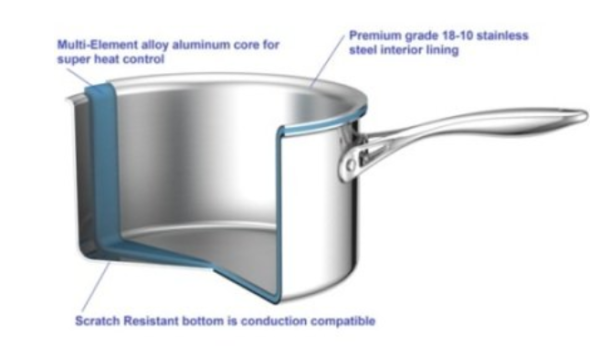
You get easy to clean stainless steel body without any need for seasoning or tough maintenance yet get the best heat distribution ability.
If you cook stir-fries regularly, don’t like tough maintenance, you may find this type of stainless steel woks the perfect choice. Like this Cooks Standard Stainless Steel is the best overall wok according to our expert chefs in Wokware, that you can find on the market.
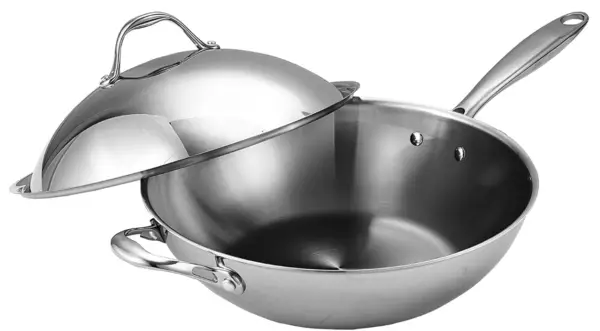
It is a flat bottomed wok yet has a beautiful depth in it. This makes the entire design of the wok perfect for stir-frying, deep-frying, searing, braising, steaming, etc. It also comes with a lid and the price range is appropriate. If you’d like to have a versatile cooking appliance in the form of a wok, this stainless steel one would be a good choice.
If you compare stainless steel wok vs carbon steel wok based on their price range, stainless steel woks often come a bit costlier. As you don’t need to season it every now and then, the price is justified compared to your hard work.
For more info on the best stainless steel wok on the market read this.
Stainless steel wok vs Cast iron wok
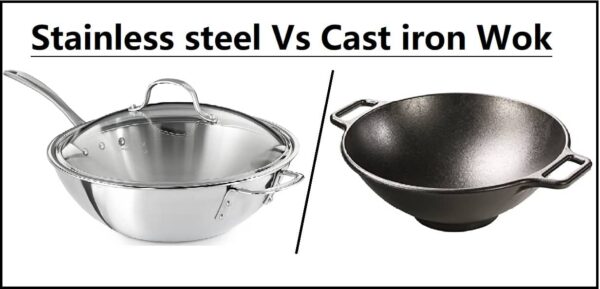
Cast iron woks are good in terms of heat transfer, distribution, and retention. Compared to carbon steel, cast iron (Read: carbon steel or cast iron wok) is inferior in heat distribution but better in retention which means it will keep the food warmer for a long period.
A stainless steel wok may develop hotspots and do not distribute heat evenly as well as a cast iron wok. Cast iron woks without a non-stick coating need to be seasoned occasionally to prevent rusting. Whereas stainless steel wok is naturally nonstick. Cast iron wok is heavier and cheaper than stainless steel wok. Also, cleaning a cast iron wok will be a little harder compared to a stainless steel wok.
When food is stuck at the bottom, a gentle scrub will clean a stainless steel wok while you may have to put a little more effort to clean a cast iron wok.
Read about: Top 15 cast iron woks on the market
For someone who enjoys cooking, does not mind seasoning and the caring process of the cast iron, wants iron infusion in food and prefers a wok that becomes an asset over time, the cast iron wok is the best choice. One such wok is the Lodge Cast iron 14-inch flat bottom wok. This wok is the most popular cast iron wok on the market and suitable for 3-4 servings.
Stainless steel wok vs Non-stick wok
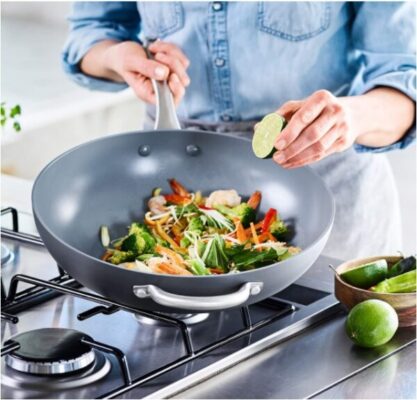
Of all the woks available on the market, non-stick woks are the easiest to maintain. However, the non-stick wok is not a material type rather a coating. Non-stick woks can come in any material built. From carbon steel, cast iron, to aluminum any material made wok can be turned into a nonstick wok.
You can literally wipe a non-stick wok with a tissue and it will be perfectly clean. They offer a significantly easier cooking experience too since food won’t stick to the bottom of the wok.
Well, ease of maintenance puts some limitations on the usage though. Most non-stick coatings get scratched easily, so you can’t use metal utensils when cooking in a wok. Also, these coatings (mostly Teflon) can come off or release toxic fumes at temperatures higher than 400 degrees F, which means that your stir-fries will not be safe to eat.
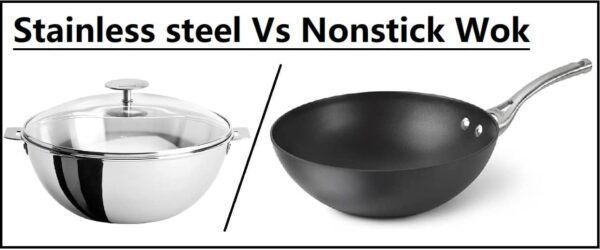
And the ideal BTU for cooking tasty Stir-fries is between 100k – 150k. Clearly, you can’t cook in a unsafe non-stick coated wok pan on high temperatures, no matter how easy to maintain it is.
However, stainless steel woks also do not need much maintenance. Of course, they are not as easy to clean as non-stick woks, but when compared to the cast iron or carbon steel woks, stainless steel woks are very easy to clean. Just soak it in water and scrub gently, the food particles will come off.
Coming to the high-temperature cooking, stainless steel woks are perfectly fine at high-heat, and you won’t have a problem with cooking restaurant-style stir-fries in it, provided you have the setup to create blistering heat.
To summarize –
Nonstick woks have a fragile surface as compared to 3-ply or 5-ply stainless steel woks. Any metal utensil may scratch the coating, and scratched nonstick wok is unhealthy to use. On high heat Teflon coated woks may release toxic fume. Whereas the food-grade 3-ply and 5-ply stainless steel wok is safe, healthy and sturdy to cook on high heat daily. Nonstick woks may come cheap and easy to maintain than stainless steel woks, but a stainless steel wok is always a better investment in terms of safety and durability.
Here is a list of the top 5 stainless steel woks on the market.
If you want to go with a nonstick wok, make sure to check our, best nonstick and healthy woks list. Here, we have only reviewed the safest nonstick woks.
Stainless steel wok vs Aluminum wok
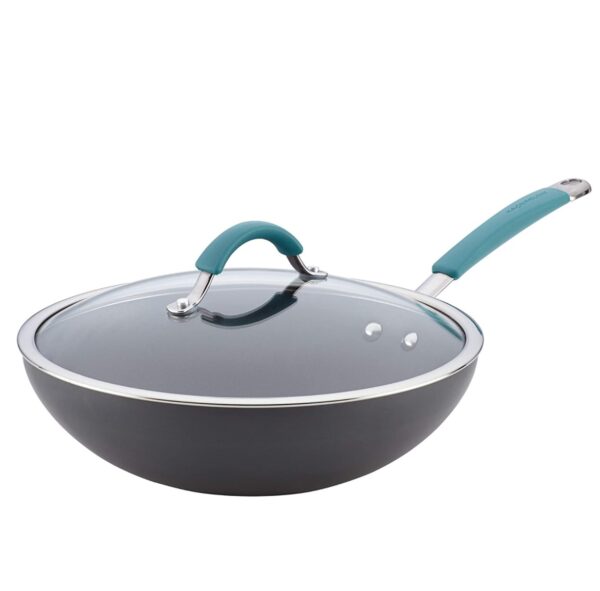
Aluminum is known for its heat conductivity. Out of all wok materials, aluminum woks offer a better heat distribution for preparing tasty stir-fries and deep-fries. At the same time, their heat capacity is low, so they will take a longer time to heat up.
Aluminum woks need continuous heating to make great stir-fries, and even taking them off the stove for a few seconds can affect the taste. On the other hand, stainless steel woks have better heat capacity, so they don’t need as much energy as aluminum woks. However, in distributing the heat throughout the wok pan aluminum is far better.
If you want both features of heat distribution and faster heating ability I suggest you go with the stainless steel woks with aluminum bottoms. Where a multi-element alloy aluminum core is sandwiched between 18-10 high-grade stainless steel sheets like the Cooks Standard stainless steel wok.
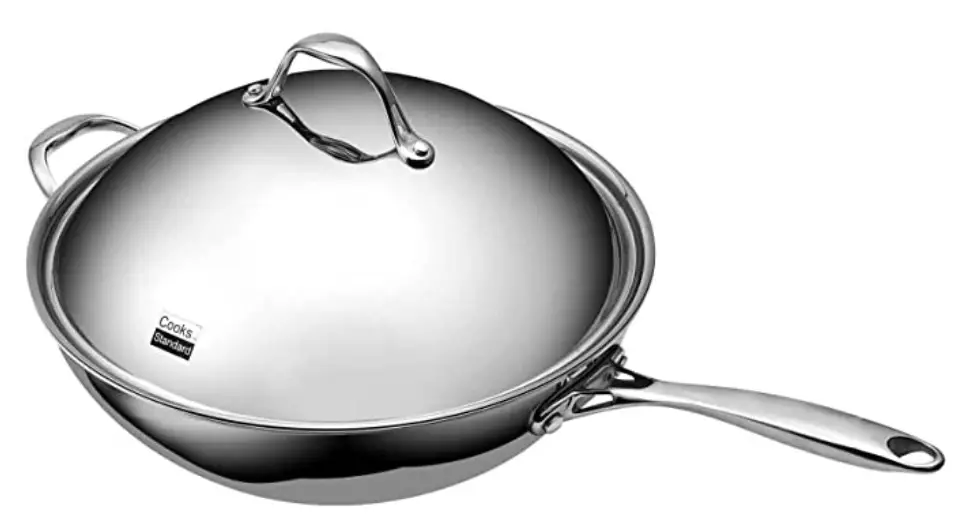
This construction give you safety from aluminum leaching into your food daily, better heat distribution and capacity, along with sturdy built that does not warp on high heat.
As far as maintenance is concerned, there’s a huge difference if you care about how your wok looks. Aluminum woks may discolor after multiple uses, and it is hard to stop that whereas stainless steel woks will stay clean and in shape even after years of usage.
Anodized aluminum is the safest, sturdiest, and better version of aluminum. To know more about anodized aluminum woks read this.
Final Thoughts:
There are other material-built woks too. But I haven’t covered them purposefully. Materials like ceramic, or other alloys are not that great to have in a wok. Hence, they don’t stand a chance in this comparison.
Also, carbon steel and cast iron made woks should be the most desired ones. But if you hate seasoning and maintaining a wok, then a good stainless steel wok may replace the cooking quality of a carbon steel or cast iron made wok.
As far as aluminum woks are concerned, they are very cheap. Also comes with a handful of pitfalls. If you have a low budget yet want to experience wok cooked meals, then go for an aluminum wok.
While choosing a non-stick wok keep in check if the coating is safe to use. However, my strong recommendation will be to always avoid them.
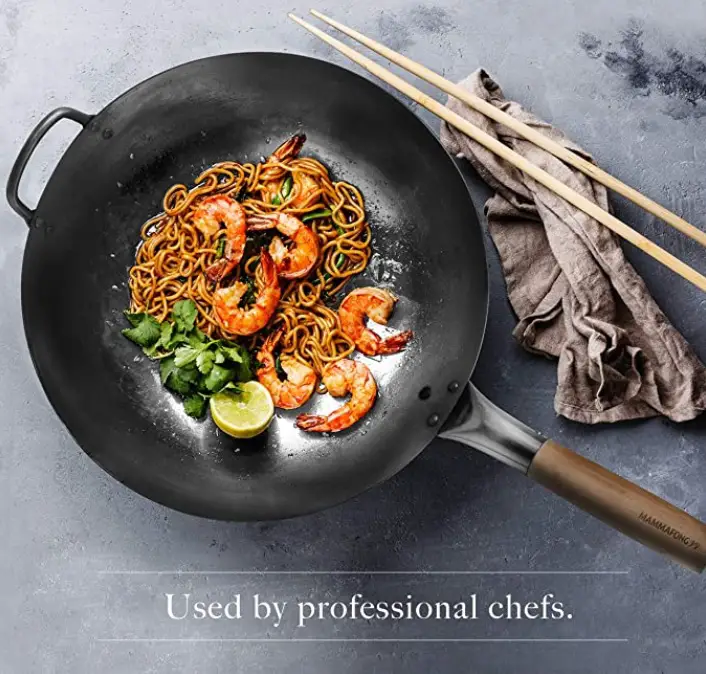
Best Carbon Steel Wok Recommended by Wokware
Mammafong 14 inch Traditional Hand Hammered Round Bottom Carbon Steel Pow Wok Set
Author: Preeunka
Editor at Wokware
She is an expert in the niche of kitchenware for 10 years now. She has given readers fact based, well researched, to the point answers of their valuable questions. Her goal is to simplify kitchen products and their utilities.
